COME SEE US!
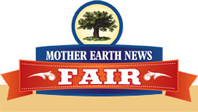 Visit us at
Visit us at
Mother Earth News Fair
Premier's booth #1221 & 1320
Puyallup, WA
May 31 - June 1, 2014
Premier's booth #151 & 153
Seven Springs, PA
September 12-14, 2014
Premier's booth -- TBA
Topeka, KS
October 25-26, 2014
2014 Polyface
Farm Field Day
July 19, 2014
Swoope, Virginia
SOLUTIONS FOR
WILDLIFE BARRIERS
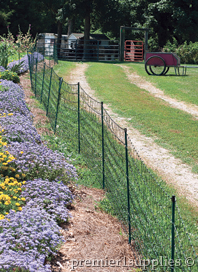
VersaNet® Plus 11/30/3 sets up easily and is less prone to sagging. Use the green net when aesthetics are important and there is minimal exposure to visitors who are not familiar with electrified netting.
Electric Netting
| • |
Fast and simple to install (see our "how-to video"). For a typical fence line, 500 ft can be installed in less than an hour. |
| • |
Needs no tools, strength or skills. |
| • |
Prone to energy problems from growing vegetation if fence line is not mowed or sprayed as needed. |
Protects: Gardens, Sweet corn, Fruit orchards, Tree plantings, Backyards, Beehives and Silage "tubes"
Keeps Out: Raccoons, Woodchucks, Opossums, Skunks, Rabbits, Dogs, Coyotes, Foxes, Bears, Nonflying Poultry, Geese/Ducks, Livestock, Wild Pigs and Deer
Netting Options:
Temporary VersaNet®
VersaNet 9/20/3 or
VersaNet Plus 9/20/3
VersaNet 11/30/3 or
VersaNet Plus 11/30/3
Semi-Permanent RaccoonNet™
RaccoonNet 4/18/12
Semi-Permanent PermaNet®
PermaNet 10/48/6
PermaNet 12/48/3 and
PermaNet Plus 12/48/3
PermaNet 12/68/6
PermaNet 19/68/3
Beehive Protection—VersaNet™ and ElectroNet®
VersaNet 9/20/3 or
VersaNet Plus 9/20/3
ElectroNet 9/35/12 or
ElectroNet Plus 9/35/12
Netting Kits
Why purchase a kit?
Includes support posts necessary for corners and curves. Netting (with extra support posts where needed) is a complete fence on its own—lacking only a suitable fence energizer. |
See our Netting Comparison Chart for more information.
PREMIER ENERGIZERS
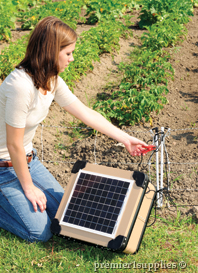
Connecting Premier's PRS 50 Solar Energizer to fencing. It should be slightly tilted toward the south to catch peak sunlight available. We prop one edge on top of the ground rod.
Premier Energizers
| 1. |
110v AC (plug-in)—Energy input is 110v AC. Mount inside buildings or in a protected area outdoors. Connected to ground rods and fence with insulated wires. |
| 2. |
AC/DC—Can either be connected to a 12v battery or plugged directly into a 110v AC outlet.
|
| 3. |
DC (battery)—Input energy is from a 6 or 12 volt DC deep-cycle battery. |
| 4. |
Solar—Consists of a solar panel that’s directly attached to a case which, in turn, encloses a DC energizer and battery. |
Energizer Kits
Why purchase a kit?
Users tell us that kits simplify their purchasing decisions—because electrified fences require energizers, ground rods, accessories, etc. And for those with minimal experience, it’s complicated to choose and buy multiple components and build fences. |
Contact Premier or call 800-282-6631 to speak with one of our fence consultants to help you determine the best energizer for your needs.
You can also view our energizer comparison charts online or in Premier's fencing catalog for help in choosing an energizer.
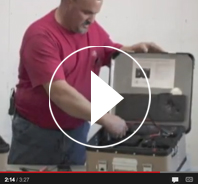
If it's the beginning of your fencing season, you'll find our video above on how to get your PRS Solar Energizer ready for fencing season helpful, with instructions and tips the folks at Premier have learned by experience.
|
 |
 |
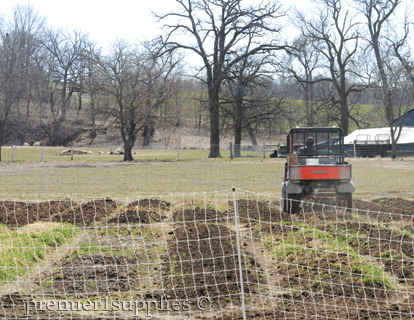
Preparing Premier's garden for spring. Adrian (Premier's gardener/shepherd) used part of a retired field disk to work the soil. Premier's PoultryNet™ in use to keep out critters, dogs and potential predators.
Getting the soil
"garden ready"
Green is quickly becoming the prevailing color we see around Premier. The fields are shifting from dull browns and grays to something significantly more pleasing to the eye. We even have a few crocuses in bloom—and the tulips are not far behind. Needless to say, Spring is here at Premier.
Folks are putting away their snow shovels and bringing out the spades and trowels to get this year's garden ready. A few ambitious folks have even tilled their gardens.
Not everyone has Iowa's current weather so we've included a few gardening guides from around the country. Have an excellent start to your gardening season!
ZONE MAP AND INFORMATION
USDA Plant Hardiness Zone Map
The 2012 USDA Plant Hardiness Zone Map is the standard by which gardeners and growers can determine which plants are most likely to thrive at a location. The map is based on the average annual minimum winter temperature, divided into 10-degree F zones.
Read More and Review Chart »
CORNELL UNIVERSITY
Vegetable Growing Basics
Choose a site that is:
| • |
Sunny. Receives at least 6 hours of direct sun daily. |
| • |
Well-drained. No standing water after heavy rains. |
| • |
Relatively level. Or build beds or terraces that run across the slope. |
| • |
Away from trees. They can shade and compete with crops for water and nutrients. |
| • |
Protected from high winds. Good air circulation, however, helps prevent disease. You may want to avoid low-lying frost pockets. |
| • |
Close to a water source. You'll need water, and it's too heavy to haul. |
Read More »
Mulches for landscaping
By Donald A. Rakow, Cornell Plantations. Originally published 7/89, reprinted 2/94, revised slightly 4/00 cpm.
Introduction
As popular as they are in contemporary landscapes, mulches are not a new concept. For as long as trees have grown in forests, leaves and needles have fallen to the ground, matted together, and formed a natural protective layer over the soil.
The English word mulch is probably derived from the German word molsch, meaning soft, beginning to decay. It no doubt referred to early gardeners' use of straw, leaves, and loose earth spread on the ground to protect the roots of newly planted trees and shrubs.
Many different natural and synthetic mulches are available today, but all perform at least three basic functions:
| • |
Reduce soil water losses. |
| • |
Suppress weeds. |
| • |
Protect against temperature extremes. |
In one study comparing various mulch materials with bare soil, soil moisture percentages in mulched plots were approximately twice as high, summer soil temperatures were reduced by 8 to 13 degrees, and the average amount of time required to remove weeds was reduced by two-thirds.
Read More »
OREGON STATE UNIVERSITY EXTENSION SERVICE
Growing Your Own
Getting Started
Choosing a garden site is as important as selecting the vegetables to grow in it. All vegetables need sunlight and fertile, well-drained soil, and they will contract fewer diseases if the site has good ventilation. Place the garden so it will be convenient to plant, care for, and harvest. Protect the garden site from invading insects or animals.
Few of us are lucky enough to have the ideal garden site. You might find that the perfect place for your sweet corn is along the back fence, where it becomes a backdrop for dahlias. Or the sunniest site for chard or beets may be along the sidewalk entry. Innovative gardeners will find spaces that fit their plants’ needs.
Read More »
Starting Your Vegetable Garden
What to grow
| • |
Favorites of the family |
| • |
Valuable crops (herbs) |
| • |
Short season crops (40-50 day crop vs. 85 day crop) |
Space needs
| • |
A sunny location (8+ hrs of sun) is crucial to plants that form fruit (tomato, cucumber, squash, eggplant, peppers, melon); many leafy vegetables (lettuce, spinach, etc) need less sun |
| • |
Choose a high spot – cold air settles in low spots and shortens the productive season; low spots also tend to have drainage problem |
| • |
Start small: 2’x2’x1’ deep container to 10’x10’+ plots |
| • |
A 30’x30’ garden will yield enough fresh produce for a family of 4 |
| • |
Intensive culture requires expert care but little space: bush bean (6”x6”), beet (4”x4”), carrot (2”x2”), chard (9”x9”), lettuce (6”x6”), onion (3”x3”), pea (2”x2”), radish (1”x1”), spinach (4”x4”), tomato (24”x24”) |
Read More »
IOWA STATE UNIVERSITY EXTENSION AND OUTREACH
Yard and Garden: Mulch
ARTICLE | THU, 06/07/2012 - 10:38
BY RICHARD JAURON, WILLY KLEIN
Mulches are commonly used to enhance the beauty of landscapes, suppress weeds, conserve soil moisture and buffer plants from the damaging effects of traffic and lawn equipment. Organic mulches also can improve the soil structure and increase the fertility of landscape soils, which often are compacted and lacking in organic matter, especially around newly constructed buildings. Horticulture specialists with Iowa State University Extension and Outreach answer mulch questions this week. To have additional gardening questions answered, contact the specialists by calling or emailing the ISU Extension and Outreach horticulture hotline at 515-294-3108 or hortline@iastate.edu.
What are the benefits of mulches?
Organic mulches serve several important functions in gardens and landscape plantings. Mulches help control annual weeds and conserve soil moisture. They reduce soil erosion by reducing the impact of raindrops and water runoff. Mulches can help reduce the severity of some diseases, such as blights on tomatoes. They help keep fruits, vegetables and flowers free of rain spattered soil. They also reduce fruit and vegetable spoilage. Organic mulches moderate soil temperatures. During the hot summer months, they help maintain cooler soil temperatures. Mulches also provide an attractive background for landscape plantings.
Read More »
AGRILIFE EXTENSION TEXAS A&M SYSTEM
Texas Home Vegetable
Gardening Guide
Joseph Masabni
Assistant Professor and Extension Horticulturist
The Texas A&M System
Home gardening continues to grow in popularity. One of every three families does some type of home gardening, according to conservative estimates, with most gardens located in urban areas. Texas gardeners can produce tasty, nutritious vegetables year-round. To be a successful gardener you will need to follow a few basic rules and make practical decisions.
Garden Site
Although many urban gardeners have little choice, selecting a garden site is extremely important. The ideal garden area gets full or nearly full sunlight and has deep, well-drained, fertile soil. The garden should be near a water outlet but not close to competing shrubs or trees. However, if you modify certain cultural practices and select the right crops, almost any site can become a highly productive garden.
Read More »
Easy Gardening Mulching
Joseph Masabni
Assistant Professor and Extension Horticulturist
The Texas A&M University System
Mulching is a long-established horticultural practice that involves spreading a layer of material on the ground around plants to protect their roots from heat, cold, or drought or to keep the fruit clean.
Mulches can be classified as inorganic or organic:
| • |
Inorganic mulches include plastic, rocks, rock chips, and other nonplant materials. Plastic is the only inorganic mulch used in vegetable gardens. |
| • |
Organic mulches include straw, compost, newspaper, sawdust, and similar materials. Shallow cultivation of the soil’s surface after a rain slows the rate of water loss from the soil. |
Value of mulches
A 4-inch layer of mulch on the soil surface, especially in sloping gardens, helps keep water from washing away soil particles. Mulches also prevent raindrops from splashing on the soil surface and reduce the spread of diseases (Fig. 1, click on read more below).
Read More »
|
|